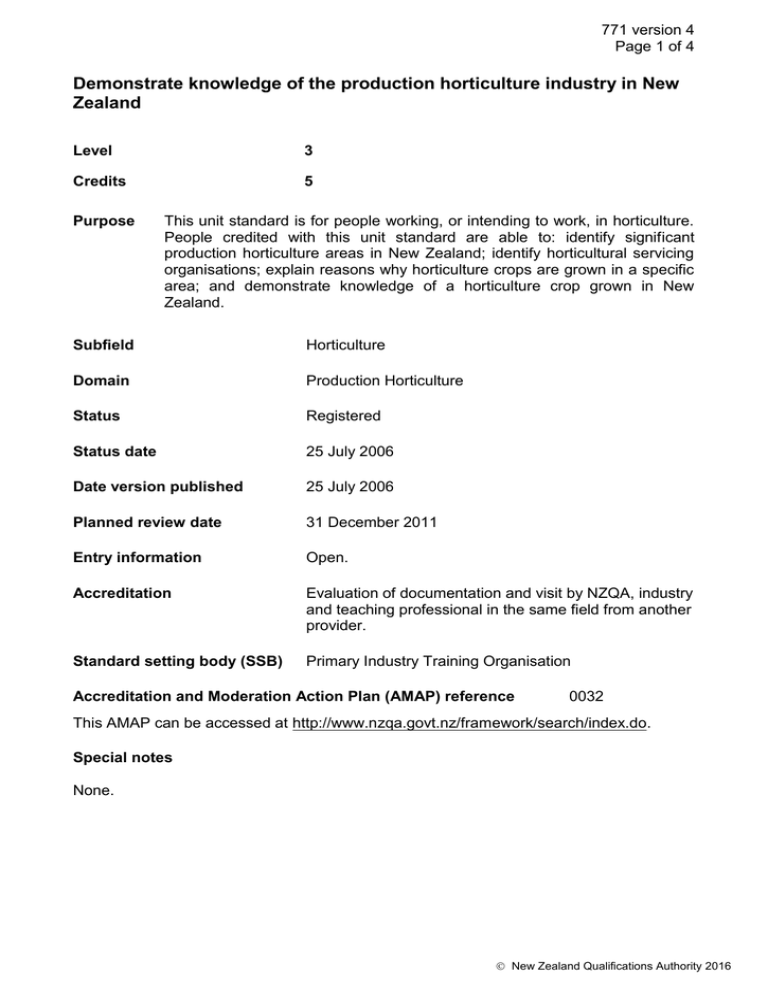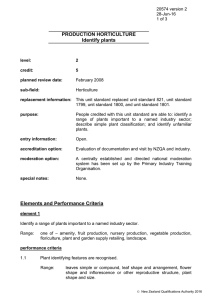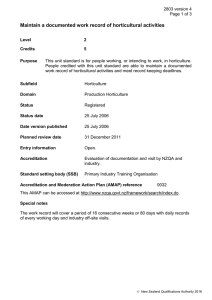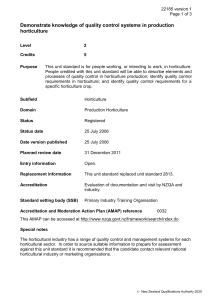Demonstrate knowledge of the production horticulture industry in New Zealand
advertisement

771 version 4 Page 1 of 4 Demonstrate knowledge of the production horticulture industry in New Zealand Level 3 Credits 5 Purpose This unit standard is for people working, or intending to work, in horticulture. People credited with this unit standard are able to: identify significant production horticulture areas in New Zealand; identify horticultural servicing organisations; explain reasons why horticulture crops are grown in a specific area; and demonstrate knowledge of a horticulture crop grown in New Zealand. Subfield Horticulture Domain Production Horticulture Status Registered Status date 25 July 2006 Date version published 25 July 2006 Planned review date 31 December 2011 Entry information Open. Accreditation Evaluation of documentation and visit by NZQA, industry and teaching professional in the same field from another provider. Standard setting body (SSB) Primary Industry Training Organisation Accreditation and Moderation Action Plan (AMAP) reference 0032 This AMAP can be accessed at http://www.nzqa.govt.nz/framework/search/index.do. Special notes None. New Zealand Qualifications Authority 2016 771 version 4 Page 2 of 4 Elements and performance criteria Element 1 Identify significant production horticulture areas in New Zealand. Performance criteria 1.1 Horticultural areas producing commercial fruit crops are identified, and types of fruit are listed for each region. Range 1.2 Horticultural areas producing commercial vegetable crops are identified, and kinds of vegetables are listed for each area. Range 1.3 potatoes, brassicas, salad vegetables, alliums, cucurbits, corn, greenhouse tomatoes, outdoor tomatoes, carrots, kumara. Horticultural areas producing commercial cut flower and foliage crops are identified, and kinds of flowers or foliage are listed for each area. Range 1.4 pip fruit, stone fruit, citrus, grapes, kiwifruit, berryfruit, subtropicals. roses, leucodendrons, proteas, gypsophila, orchids, gentiana, paeonies, sandersonia, zantedeschia. Horticultural areas important to the nursery industry are identified, and kinds of crops are listed for each area. Range bedding plants, vegetable plants, fruit trees, deciduous trees, evergreen trees, perennials, main retail garden centres, indoor plants. Element 2 Identify horticultural servicing organisations. Performance criteria 2.1 Main marketing systems are described in terms of crops handled and distributed. Range 2.2 marketing boards, auction, contract sales, direct sales. Local sources of supply are listed for a range of horticulture material and equipment. Range two agencies for each of the following – agrichemicals, safety equipment, fertilisers, machinery and equipment, packaging materials. New Zealand Qualifications Authority 2016 771 version 4 Page 3 of 4 2.3 Horticulture organisations are listed with a description of their functions. Range three examples of each of the following – advisory, research and training. Element 3 Explain reasons why horticulture crops are grown in a specific area. Range any two of the following – pipfruit, grapes, potatoes, greenhouse tomatoes, orchids, paeonies. Performance criteria 3.1 Environmental factors are identified for optimum crop production for each crop. 3.2 Marketing systems are outlined for each crop. 3.3 Management factors are outlined for each crop. Range staffing, servicing, consultancy, packaging, transport. Element 4 Demonstrate knowledge of a horticulture crop grown in New Zealand. Range one of the following – apples, kiwifruit, greenhouse tomatoes, onions, kumara, orchids, roses, grapes. Performance criteria 4.1 Horticulture production statistics are sourced. Range national export and local market earnings, number of people employed, area in crop production, percentage of total horticulture production. 4.2 Production schedule is described including main seasonal operations. 4.3 Marketing of the exported crop is described from the time it leaves the property to its market destinations. Please note Providers must be accredited by the Qualifications Authority, or an inter-institutional body with delegated authority for quality assurance, before they can report credits from assessment against unit standards or deliver courses of study leading to that assessment. Industry Training Organisations must be accredited by the Qualifications Authority before they can register credits from assessment against unit standards. New Zealand Qualifications Authority 2016 771 version 4 Page 4 of 4 Accredited providers and Industry Training Organisations assessing against unit standards must engage with the moderation system that applies to those standards. Accreditation requirements and an outline of the moderation system that applies to this standard are outlined in the Accreditation and Moderation Action Plan (AMAP). The AMAP also includes useful information about special requirements for organisations wishing to develop education and training programmes, such as minimum qualifications for tutors and assessors, and special resource requirements. Comments on this unit standard Please contact the Primary Industry Training Organisation via their website www.primaryito.ac.nz if you wish to suggest changes to the content of this unit standard. New Zealand Qualifications Authority 2016



